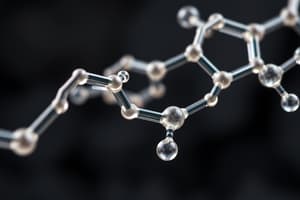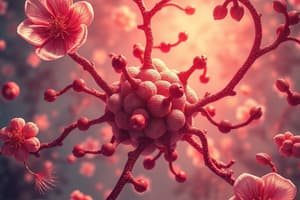Podcast
Questions and Answers
Which amino acid is classified as nutritionally essential but is also sometimes considered semiessential?
Which amino acid is classified as nutritionally essential but is also sometimes considered semiessential?
- Tyrosine
- Proline
- Isoleucine
- Histidine (correct)
How many enzymes are required for the synthesis of lysine?
How many enzymes are required for the synthesis of lysine?
- 3
- 1
- 8 (correct)
- 5
Which of the following amino acids is nonessential and requires only 1 enzyme for its synthesis?
Which of the following amino acids is nonessential and requires only 1 enzyme for its synthesis?
- Proline
- Cysteine
- Threonine
- Alanine (correct)
Which amino acid has the highest number of enzymes required for its synthesis?
Which amino acid has the highest number of enzymes required for its synthesis?
Which amino acid is not classified as essential and requires 3 enzymes for its synthesis?
Which amino acid is not classified as essential and requires 3 enzymes for its synthesis?
Flashcards are hidden until you start studying
Study Notes
Essential and Nonessential Amino Acids
- Arginine and histidine are considered semiessential as they can be synthesized but not at a rate sufficient for growth in children.
- Essential amino acids must be obtained from the diet.
- Nonessential amino acids can be synthesized by the body.
- The number of enzymatic steps required to synthesize each amino acid varies greatly.
Porphyrins
- Porphyrins are formed from four molecules of porphobilinogen.
- The synthesis of porphyrins involves a series of complex enzymatic reactions.
- Genetic defects in the porphyrin synthesis pathway lead to porphyrias, which are inherited disorders.
- Porphyrias can be hepatic or erythropoietic depending on where the defect occurs.
Porphyrias
- Congenital erythropoietic porphyria affects mainly erythrocytes and causes an accumulation of uroporphyrinogen I.
- Uroporphyrinogen I stains urine red, causes teeth to fluoresce in UV light, and increases skin sensitivity to light.
- Acute intermittent porphyria affects the liver and is not typically photosensitive.
- Symptoms include abdominal pain, vomiting, constipation, paralysis, and psychological symptoms.
Bile Pigments
- The normal human erythrocyte life span is approximately 120 days.
- Old erythrocytes are degraded by the spleen.
- Heme degradation to bilirubin involves:
- Cleavage of the α-methene bridge to form biliverdin.
- Reduction of biliverdin to form bilirubin.
- Bilirubin is transported to the liver and conjugated with glucuronide to make it water-soluble for excretion in bile.
- Jaundice occurs when bilirubin levels in the blood are elevated due to impaired liver or bile function.
Creatine and Glutathione
- Phosphocreatine (PC) is an important energy reservoir in skeletal muscle and is derived from creatine (Cr).
- Polyamines are conjugated with DNA and are derived from ornithine.
Neurotransmitters
- Tyrosine is the precursor for dopamine, norepinephrine, and epinephrine.
- Dopamine levels are correlated with blood pressure changes.
- Parkinson's disease is associated with dopamine underproduction and is treated with L-dopa.
- Schizophrenia is associated with dopamine overproduction.
- GABA is an inhibitory neurotransmitter produced from glutamate.
- GABA underproduction is associated with epilepsy and is used to treat seizures and hypertension.
- Tryptophan is the precursor for serotonin.
Nitric Oxide
- Nitric oxide (NO) is a short-lived signaling molecule produced from arginine by nitric oxide synthase (NOS).
- NO is a free radical gas that serves as a transient signal molecule.
Lignin, Tannin, and Auxin
- Lignin is a complex rigid polymer derived from phenylalanine and tyrosine.
- Tannins inhibit oxidation.
- Tryptophan is the precursor for indole-3-acetate (IAA) or auxin, which regulates plant growth.
Alkaloids
- Alkaloids are natural plant compounds with a basic character containing at least one nitrogen atom in a heterocyclic ring.
- They are characterized by their basic properties, complex structures, specific physiological actions, and plant origin.
- Alkaloids are often highly poisonous but used medicinally in small quantities.
Studying That Suits You
Use AI to generate personalized quizzes and flashcards to suit your learning preferences.




